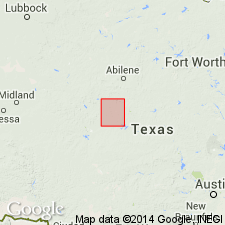
- Usage in publication:
-
- Tye formation
- Modifications:
-
- Original reference
- Dominant lithology:
-
- Clay
- Sandstone
- AAPG geologic province:
-
- Permian basin
Summary:
Pl. opp. p. 96. Tye formation. Soft red clays with thin unimportant sandstones in upper part. Thickness 340 feet. Is basal part of Clear Fork beds. Underlies Bullwagon dolomite and overlies Wichita beds. [Age is Permian.]
[Probably named from Tye, Taylor Co., central northern TX.]
Source: US geologic names lexicon (USGS Bull. 896, p. 2205).

- Usage in publication:
-
- Tye formation
- Modifications:
-
- Not used
- AAPG geologic province:
-
- Permian basin
Summary:
Pg. 47. [Tye formation of Wrather (1917) replaced with Vale formation.] Vale formation. Red shale, some of it quite sandy, extending from top of Ferguson's Ford section to base of section at Smith place, on Bull Hollow, [Runnels County, central northern Texas]. Thickness 154 feet in Runnels County; Wrather gives thickness of 340 feet in Taylor County. Replaces Tye formation of Wrather, which is preoccupied by an igneous formation and also conflicts with Tyee formation of Pacific Coast. Basal division of Clear Fork stage. Overlies Arroyo formation, of Wichita stage. Named from old P.O. of Vale, on Ballinger-Maverick Road, on east side of Valley Creek, Runnels Co., central northern TX.
Source: US geologic names lexicon (USGS Bull. 896, p. 2205).
For more information, please contact Nancy Stamm, Geologic Names Committee Secretary.
Asterisk (*) indicates published by U.S. Geological Survey authors.
"No current usage" (†) implies that a name has been abandoned or has fallen into disuse. Former usage and, if known, replacement name given in parentheses ( ).
Slash (/) indicates name conflicts with nomenclatural guidelines (CSN, 1933; ACSN, 1961, 1970; NACSN, 1983, 2005, 2021). May be explained within brackets ([ ]).

